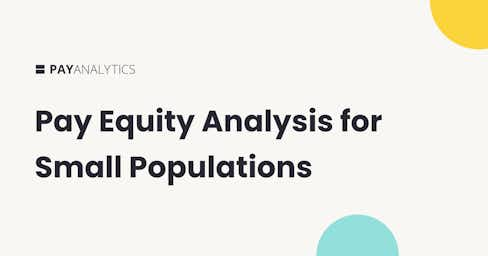A Guide to the EU Pay Transparency Directive 2025 | Download our eGuide for free

Pay Equity Analysis for Small Populations
Pay equity is important in companies of all sizes. Yet organizations with small populations face unique challenges when conducting a pay equity analysis. This article reviews some of these concerns and ways to address them.
Data collection
In any analysis, it’s important to collect data on key factors like the employee’s job role and experience. Organizations with small population sizes need to be careful not to include too many factors. This is because each category needs to contain enough employees to make the comparisons between demographic groups meaningful.
When designing the pay equity analysis, then, small organizations should pay attention to category definitions. They need to be narrow enough that all the employees in the category are similar. Yet they also need to contain enough employees to support demographic comparisons.
For this reason, smaller organizations often end up excluding some factors. For example, in a given organization, men may be more experienced on average, but experience is not included in the model. This exclusion will not affect the magnitude of the adjusted pay gap, but it will affect the precision of the targeted raise suggestions.
Quality review
During the quality review of the analysis, small organizations should do the following:
Conduct a special review of any categories that have workers of only one gender. For these categories, the average salary needs to be examined in light of the company’s whole salary structure.
Make sure the magnitudes of the different factors in the analysis are in line with what would be expected.
Make sure the magnitudes of the factors are in line with the organization’s overall compensation structure.
Setting an equal pay gap target size
In an ideal scenario where there is no bias, a company’s pay gap oscillates around zero. It makes sense, then, that many decision-makers in companies of all sizes want to set 0% as the pay gap goal. It’s a clear target, easy for employees, managers, and all other stakeholders to understand.
Yet reaching (and maintaining) a zero pay gap can be especially tricky for small populations. This is because each HR decision has a proportionately bigger impact than it would for a larger company. In addition, many regulators may allow a pay gap that is above zero as long as the gap size is not statistically significant.
So many small organizations face a trade-off. For example, a 3% pay gap that is not statistically significant would be easier to attain and would satisfy regulators. However, employees might still feel that the company isn’t doing enough.
In this case, companies with strong pay equity motives might consider setting an internal pay gap threshold. Any pay gap below that threshold, regardless of its statistical significance, would be not considered important.
With attention to these considerations, small organizations generally get good results from a pay equity analysis. Employees want to work for companies that value fairness. So when the pay gap shrinks, small organizations may find it easier to recruit and retain great workers.
Want to learn about the benefits?
Start with our comprehensive article on pay equity or drop us a line.






